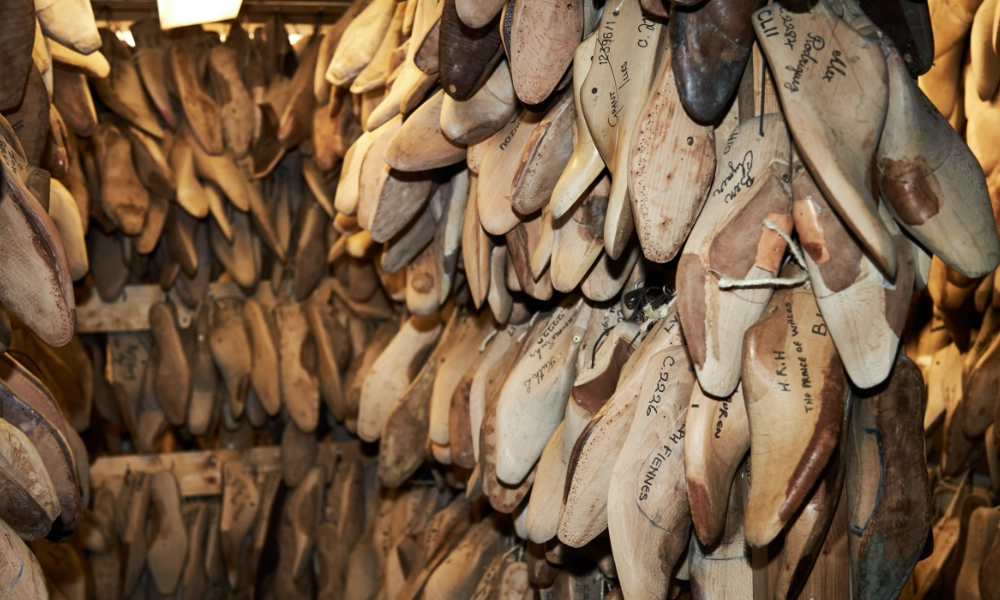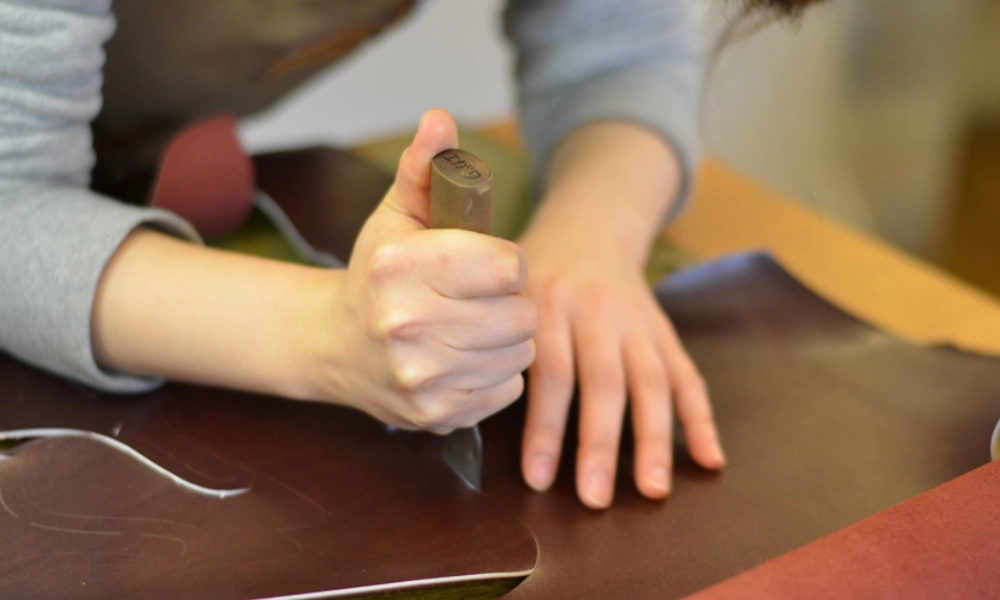

Bespoke shoes are the epitome of luxury footwear. They are tailored to the specific measurements and preferences of the wearer, resulting in a fit and style unmatched by mass-produced shoes. From the design process to the final product, bespoke shoemaking is a painstaking art that requires meticulous attention to detail.
Bespoke shoemaking has a rich and fascinating history that spans centuries. The earliest records of bespoke shoemaking date back to medieval Europe, where shoemakers were highly skilled artisans who crafted shoes by hand using traditional techniques.
During this time, bespoke shoemaking was considered a luxury reserved for the wealthy and elite. Shoemakers would work closely with their clients to create shoes that were not only functional but also stylish and fashionable. The shoes were made from high-quality materials such as leather, silk, and sheepskin and were crafted with incredible attention to detail.
Traditional bespoke shoemaking involves dozens of steps carefully executed by skilled artisans. The process begins with creating a wooden last; a foot-shaped mould used as a foundation for the shoe. The shoemaker then cuts and shapes the leather to fit the last before hand-stitching the seams and adding any decorative elements.
One of the most important aspects of bespoke shoemaking is using high-quality materials. Skilled shoemakers only use the finest materials, such as leather tanned using traditional methods, silk threads, and sheepskin linings. This ensures that the shoes are soft and supportive and incredibly durable, able to withstand years of wear and tear.
Despite the rise of mass-produced footwear during the Industrial Revolution, the demand for bespoke shoes continued to thrive. This was driven by those seeking superior craftsmanship, unique designs, and personalized fit that could not be found in mass-produced shoes.
In recent years, bespoke shoemaking has grown in popularity, spurred by a renewed interest in handmade craftsmanship, customization, and sustainability. Today, there are a growing number of modern bespoke shoemakers who combine traditional techniques with contemporary designs, catering to a diverse range of customers.
These modern shoemakers often use innovative materials and techniques, such as 3D printing and laser cutting, to create shoes that are not only beautiful but also comfortable and functional. They work closely with their clients to create shoes that are truly unique, taking into account factors such as foot shape, gait, and personal style.
Furthermore, many modern bespoke shoemakers are committed to sustainability, using eco-friendly materials and production methods to create beautiful and environmentally responsible shoes.
Overall, the history of bespoke shoemaking is a testament to the enduring appeal of handmade craftsmanship and the importance of quality materials and attention to detail. Whether traditional or modern, bespoke shoemaking continues to captivate and inspire people worldwide.
The bespoke shoe design process is a collaborative effort between the shoemaker and the client. It starts with an initial consultation, during which the shoemaker takes precise measurements of the client's feet and discusses their design preferences.
But the bespoke shoe design process is more than just taking measurements and selecting materials. It's a true partnership between the client and the shoemaker, with each party bringing their unique expertise. The shoemaker's knowledge of shoe construction and design is complemented by the client's understanding of their style and comfort needs. Together, they create a truly one-of-a-kind shoe.
During the initial consultation, the shoemaker will take the client's foot measurements, paying close attention to each foot's length, width, and arch height. They may also ask about the client's lifestyle and wardrobe preferences to create a shoe that fits their lifestyle and personal style.
For example, if the client spends much time on their feet, the shoemaker may recommend a design that provides extra support or cushioning. Or, if the client has a particular colour or texture in mind, the shoemaker can help them select the perfect leather to achieve their desired look.
Once the measurements are taken, clients can select the materials and styles they want for their bespoke shoes. Shoemakers typically offer a variety of leathers, from calf to exotic skins, as well as a range of colours and finishes. The client can also choose from various designs, including oxfords, brogues, and loafers, among others.
But the options don't stop there. Shoemakers can also incorporate unique details into the design, such as hand-painted patterns or intricate stitching. The possibilities are truly endless.
After selecting the materials and style, the shoemaker will work with the client to customize the shoe design for optimal comfort and aesthetics. This can include adjusting the shoe's fit, modifying the toe box's shape, or adding special details like personalized monograms or unique stitching patterns.
The shoemaker will also consider the client's foot shape and any specific comfort needs they may have. For example, if the client has a high arch, the shoemaker may add extra padding to the insole to provide additional support.
Overall, the bespoke shoe design process is a true collaboration between the client and the shoemaker. It's an opportunity to create a shoe that is beautiful and unique and perfectly tailored to the client's individual needs and preferences.

The last is a critical component in bespoke shoemaking, as it is the foundation for the shoe. It is a wooden mould shaped like the client's foot, made by hand from a wood block and adjusted throughout the design process.
To create a bespoke last, a skilled shoemaker will use a combination of hand tools, including knives, rasps, and sandpaper, to shape a block of wood into the desired shape. Hand-carving a wooden last is a true art form, requiring precision, skill, and patience.
The first step in creating a wooden last is accurately measuring the client's foot. These measurements are then used to create a rough outline of the last. From there, the shoemaker will use a combination of tools to shape the last, carefully carving away excess wood to create the perfect shape.
One of the most important aspects of hand-carving a wooden last is achieving the correct arch height. The arch of the foot plays a crucial role in the overall fit and comfort of the shoe, and a poorly designed last can lead to discomfort and even long-term foot problems.
The last is critical to the fit and comfort of the shoe, as it determines the shape and structure of the shoe's upper. In bespoke shoemaking, the last is created specifically for the client's foot, ensuring a perfect fit that cannot be achieved with off-the-shelf shoes.
Another important aspect of the last is its effect on the shoe's aesthetics. The shape of the last will determine the overall shape of the shoe, from the toe box to the heel. A well-designed last can create a beautiful, elegant shoe that complements the client's foot and style.
The last will be adjusted throughout the shoemaking process to ensure a perfect fit. The shoemaker will check the fit with each step, making adjustments as needed to ensure that the shoe conforms to the shape of the client's foot.
This process may involve adding or removing material from the last or reshaping it to achieve the desired fit. The shoemaker may also use padding or other materials to adjust the shoe's fit, ensuring that it is comfortable and supportive.
Overall, the art of last-making is a crucial component of bespoke shoemaking. A well-designed last can make all the difference in the fit, comfort, and aesthetics of a handmade shoe and is a testament to the skill and artistry of the shoemaker.

The upper part of the shoe encases the foot and provides support and protection. It is the most visible and customizable part of the shoe, and therefore, it requires the most attention to detail and precision.
The first step in crafting the upper is cutting and skiving the leather. The shoemaker will carefully select the leather, considering factors such as quality, texture, and color. They will then use precise measurements and cutting techniques to cut the leather into the desired shape. This process requires a steady hand and a keen eye for detail, as even the slightest mistake can affect the fit and appearance of the shoe.
After the leather is cut, the shoemaker may use a skiving knife to thin out certain areas of the leather. This technique creates a smoother finish and reduces bulk in areas where the leather overlaps or folds, such as the seams and edges. Skiving is a delicate process that requires a high level of skill and experience, as it can easily damage the leather if not done correctly.

Once the leather is cut and prepared, the shoemaker will assemble the upper components. This involves stitching together the various leather pieces, including the vamp, quarters, and heel counter. The shoemaker may use various techniques, such as welt construction or hand-sewn welting, depending on the style and design of the shoe.
Welt construction involves attaching a strip of leather, known as the welt, to the upper and sole of the shoe. This technique provides added durability and support to the shoe and a distinctive aesthetic. On the other hand, hand-sewn welting involves stitching the upper and sole together by hand, using a needle and thread. This technique is time-consuming and requires a high level of skill, but it results in a comfortable and durable shoe.
After assembling the upper components, the shoemaker will move on to hand-stitching and detailing. This is where the shoe truly comes to life, as the shoemaker adds personalized touches and unique features.
The shoemaker will hand-stitch the upper to the sole, using various stitching techniques to create a secure and durable bond. They may also add decorative touches, such as contrasting stitching, decorative perforations, or customized hardware, to enhance the shoe's overall appearance.
In conclusion, bespoke shoemaking is a complex and demanding art that requires years of training and practice. But for those who appreciate the beauty and value of handmade craftsmanship, it is a true labour of love, resulting in shoes that are stylish, comfortable, durable, and timeless. Crafting the upper is just one part of the process, but it is a crucial step in creating a functional and beautiful shoe.